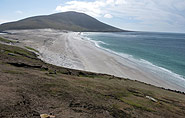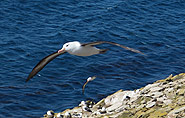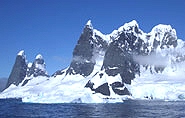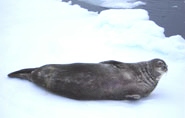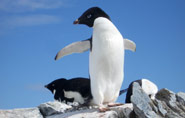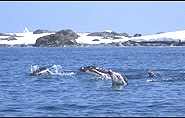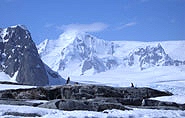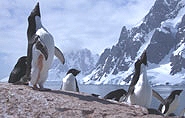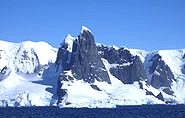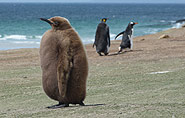Antarctica - the sixth continent
To the Antarctic Peninsula, Falkland, and to the South-Shetland Islands
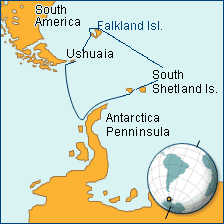 |
|
19 -21 days: Cruise with expedition ships
|
|
|
Voyage to South Georgia
|
|
|
Ushuaia - southernmost city of South America
|
|
|
Wonderful wildlife: whales, seals, penguins, sea-elephants, sea-lepards, albatrosses,...
|
There are many highlights during an Antarctica expedition: the crossing of the antarctic convergence, the Drake's Passage and the landings on the Antarctic Peninsula. See mighty icebergs, you'll visit historic places and research-stations, penguin-colonies and see many animals in their natural surroundings: seals, whales, sea elephants, birds and so on. A tour with undescribable beautiful impressions.
1. - 2. Day:
Travel to Ushuaia Argentina (individual)
3. Day:
Today is the first day of our adventure. In the afternoon, we embark in Ushuaia, Tierra del Fuego, the southernmost city in the world located in the shadow of the Andes and right at the Beagle Channel
We set sail and begin our voyage leaving behind Ushuaia and charting a course through the Beagle Channel.
4. Day: At Sea
Our guests have the chance to spend plenty of time with our onboard polar experts. They will be educating us as we go on the wonders of Antarctica. Sailing northeast, the ship is followed by several species of albatrosses, storm petrels, shearwaters and diving petrels.
5. Day: Falkland Islands
In the Falkland Islands (Malvinas) we plan to spend the whole day on the fascinating western side of the archipelago. A hike along the shore of Carcass Island will give us views of Magellanic and Gentoo-Penguins, as well as close encounters with water fowl and Night herons and passarines. In addition, on Saunders we will be able to observe four species of breeding penguins (Gentoo, King, Magellanic and Rockhopper), Black-browed Albatrosses and King Cormorants.
1. - 2. Day:
Travel to Ushuaia Argentina (individual)
3. Day:
Today is the first day of our adventure. In the afternoon, we embark in Ushuaia, Tierra del Fuego, the southernmost city in the world located in the shadow of the Andes and right at the Beagle Channel
We set sail and begin our voyage leaving behind Ushuaia and charting a course through the Beagle Channel.
4. Day: At Sea
Our guests have the chance to spend plenty of time with our onboard polar experts. They will be educating us as we go on the wonders of Antarctica. Sailing northeast, the ship is followed by several species of albatrosses, storm petrels, shearwaters and diving petrels.
5. Day: Falkland Islands
In the Falkland Islands (Malvinas) we plan to spend the whole day on the fascinating western side of the archipelago. A hike along the shore of Carcass Island will give us views of Magellanic and Gentoo-Penguins, as well as close encounters with water fowl and Night herons and passarines. In addition, on Saunders we will be able to observe four species of breeding penguins (Gentoo, King, Magellanic and Rockhopper), Black-browed Albatrosses and King Cormorants.
6. Day: Stanley, Falkland Islands
In Stanley, the capital of the Falklands, we can experience Falkland culture, which has some South American characteristics as well as Victorian charm. In Stanley and the surrounding area we can see quite an important number of stranded clippers from a century ago. All passengers are free to wander around on their own. We recommend a visit to the local church and museum.
7. - 8. Day: At Sea
At sea, on our way to South Georgia we will cross the Antarctic Convergence. Entering Antarctic waters, the temperature will drop by as much as 10 degrees C in the time span of only a few hours. Near the Convergence we will see a multitude of southern seabirds near the ship; several species of Albatrosses, Shearwaters, Petrels, Prions and Skuas.
In Stanley, the capital of the Falklands, we can experience Falkland culture, which has some South American characteristics as well as Victorian charm. In Stanley and the surrounding area we can see quite an important number of stranded clippers from a century ago. All passengers are free to wander around on their own. We recommend a visit to the local church and museum.
7. - 8. Day: At Sea
At sea, on our way to South Georgia we will cross the Antarctic Convergence. Entering Antarctic waters, the temperature will drop by as much as 10 degrees C in the time span of only a few hours. Near the Convergence we will see a multitude of southern seabirds near the ship; several species of Albatrosses, Shearwaters, Petrels, Prions and Skuas.
9. - 12. Day: South Georgia
In the afternoon of day 9 we arrive at our first landing site in South Georgia. We might visit the bay of Elsehul, with its very active fur seal breeding beach, and then set course to Right Whale Bay, Salisbury Plain, Godthul, St. Andrews Bay, Gold Harbour, Cooper Bay and Drygalski Fjord to give you a good opportunity to see a wide spectrum of landscapes and wildlife, like the introduced Reindeer, Elephant seals, Fur seals, King and Macaroni Penguins. One of the highlights might be our visit to Prion Island, where we will witness the breeding efforts of the huge Wandering Albatross and enjoy watching their displays. At Fortuna Bay we might try to follow in the footsteps of the great British Explorer Ernest Shackleton and hike over to Stømness Bay. There and at Grytviken we’ll see an abandoned whaling village, where King Penguins now walk in the streets and seals have taken over the buildings. At Grytviken we’ll also offer a visit to the Whaling History Museum as well as to Shackleton’s grave near by. We will depart from South Georgia in the afternoon of day 12.
In the afternoon of day 9 we arrive at our first landing site in South Georgia. We might visit the bay of Elsehul, with its very active fur seal breeding beach, and then set course to Right Whale Bay, Salisbury Plain, Godthul, St. Andrews Bay, Gold Harbour, Cooper Bay and Drygalski Fjord to give you a good opportunity to see a wide spectrum of landscapes and wildlife, like the introduced Reindeer, Elephant seals, Fur seals, King and Macaroni Penguins. One of the highlights might be our visit to Prion Island, where we will witness the breeding efforts of the huge Wandering Albatross and enjoy watching their displays. At Fortuna Bay we might try to follow in the footsteps of the great British Explorer Ernest Shackleton and hike over to Stømness Bay. There and at Grytviken we’ll see an abandoned whaling village, where King Penguins now walk in the streets and seals have taken over the buildings. At Grytviken we’ll also offer a visit to the Whaling History Museum as well as to Shackleton’s grave near by. We will depart from South Georgia in the afternoon of day 12.
13. Day: At Sea
At sea, where the ship is again followed by a multitude of seabirds. At some point we might encounter sea-ice, and it is at the ice-edge where we might have a chance to see some high-Antarctic species like the McCormick Skua and Snow Petrel.
14. Day: South Orkney Islands
We are planning on a visit to Orcadas station, an Argentinean base located in the South Orkney Islands. The friendly base personnel will show us their facilities and we can enjoy the wonderful views of the surrounding glaciers.
15. Day: At Sea
At sea, where the ship is again followed by a multitude of seabirds. At some point we might encounter sea-ice, and it is at the ice-edge where we might have a chance to see some high-Antarctic species like the McCormick Skua and Snow Petrel.
14. Day: South Orkney Islands
We are planning on a visit to Orcadas station, an Argentinean base located in the South Orkney Islands. The friendly base personnel will show us their facilities and we can enjoy the wonderful views of the surrounding glaciers.
15. Day: At Sea
16. - 18. Day: Antarctic Peninsula
We will sail into the Weddell Sea through the ice-clogged Antarctic Sound. Huge tabular icebergs will announce our arrival to the eastern side of the Antarctic Peninsula. We plan to visit Brown Bluff where we may set foot on the Continent.
Charlotte Bay on the west coast of Graham Land was discovered by Adrien de Gerlache during the 1897-99 Belgica expedition and named after the fiancée of Georges Lecointe, Gerlache's executive officer, hydrographer and second-in-command of the expedition.
At Portal Point there used to be a Falkland Islands Dependency Survey (British Antarctic Survey from 1962) hut which was built there between Brabant Island and the Danco Coast in 1956. The hut has been removed to the Falkland Islands Museum in Stanley.
Portal Point served as the gateway for a route to the polar plateau. Immediately behind the low point on which the hut was located the (usually snow-covered) land rises steeply upslope toward the plateau.
The topography of the surrounding area is mountainous, with nunataks rising through the ice. Charlotte Bay is often filled with icebergs. Mostly we see seals on floes in Charlotte Bay, and occasional, kelp gulls, skuas, shags, or penguins. From the slope above Portal Point, and at its highest point, there are excellent views of Charlotte Bay. In Wilhelmina Bay we will admire the rugged ice coated mountains of the Arctowski Pensinsula.
At Deception Island, we will try to land at Baily Head home to a colony of ten thousands Chinstrap Penguins (please note this landing is not always guaranteed and is only possible in good weather conditions). Good walkers may hike from Baily Head over the ridge of the crater into Whalers Bay, while our ship braves its entrance into the crater through the spectacular Neptune’s Bellow into the ring of Deception Island.
Deception itself is a sub-ducted crater, which opens into the sea, creating a natural harbour for the ship. Here we find hot springs, an abandoned whaling station, thousands of Cape Pigeons and many Dominican Gulls, Brown and South Polar Skuas and Antarctic Terns. Wilson’s Storm Petrels and Black-bellied Storm Petrels nest in the ruins of the whaling station in Whalers Bay. We leave from here to the open sea with direction Ushuaia.
19. -20. Day: Drake Passage
On our way north we are again followed by a great selection of seabirds while crossing the Drake Passage.
21. Day: Ushuaia
In the early morning, we will arrive back in Ushuaia. It is time to say farewell to your crew and fellow travelers. Guests will be transported to their hotels or to the airport for return flights home.
22. Day:
Arrival at your destination
We will sail into the Weddell Sea through the ice-clogged Antarctic Sound. Huge tabular icebergs will announce our arrival to the eastern side of the Antarctic Peninsula. We plan to visit Brown Bluff where we may set foot on the Continent.
Charlotte Bay on the west coast of Graham Land was discovered by Adrien de Gerlache during the 1897-99 Belgica expedition and named after the fiancée of Georges Lecointe, Gerlache's executive officer, hydrographer and second-in-command of the expedition.
At Portal Point there used to be a Falkland Islands Dependency Survey (British Antarctic Survey from 1962) hut which was built there between Brabant Island and the Danco Coast in 1956. The hut has been removed to the Falkland Islands Museum in Stanley.
Portal Point served as the gateway for a route to the polar plateau. Immediately behind the low point on which the hut was located the (usually snow-covered) land rises steeply upslope toward the plateau.
The topography of the surrounding area is mountainous, with nunataks rising through the ice. Charlotte Bay is often filled with icebergs. Mostly we see seals on floes in Charlotte Bay, and occasional, kelp gulls, skuas, shags, or penguins. From the slope above Portal Point, and at its highest point, there are excellent views of Charlotte Bay. In Wilhelmina Bay we will admire the rugged ice coated mountains of the Arctowski Pensinsula.
At Deception Island, we will try to land at Baily Head home to a colony of ten thousands Chinstrap Penguins (please note this landing is not always guaranteed and is only possible in good weather conditions). Good walkers may hike from Baily Head over the ridge of the crater into Whalers Bay, while our ship braves its entrance into the crater through the spectacular Neptune’s Bellow into the ring of Deception Island.
Deception itself is a sub-ducted crater, which opens into the sea, creating a natural harbour for the ship. Here we find hot springs, an abandoned whaling station, thousands of Cape Pigeons and many Dominican Gulls, Brown and South Polar Skuas and Antarctic Terns. Wilson’s Storm Petrels and Black-bellied Storm Petrels nest in the ruins of the whaling station in Whalers Bay. We leave from here to the open sea with direction Ushuaia.
19. -20. Day: Drake Passage
On our way north we are again followed by a great selection of seabirds while crossing the Drake Passage.
21. Day: Ushuaia
In the early morning, we will arrive back in Ushuaia. It is time to say farewell to your crew and fellow travelers. Guests will be transported to their hotels or to the airport for return flights home.
22. Day:
Arrival at your destination
Notes:
Please be aware, that this is the planned course of the trip. The actual implementation depends on the weather and the IAATO conditions. The captain keeps the right to adjust the trip-course according to the actual conditions, without prior communication.
The language on board is English
Please be aware, that this is the planned course of the trip. The actual implementation depends on the weather and the IAATO conditions. The captain keeps the right to adjust the trip-course according to the actual conditions, without prior communication.
The language on board is English
Performances
Included is:
- Cruise on board of Plancius or Ortelius
- full-board with coffee, tea
- Zodiac excursions
- experienced team of guides and lecturers
- Program and lectures on board
- Transfers in Ushuaia
- Harbour-fees
- Expedition Handbook
Included is:
- Cruise on board of Plancius or Ortelius
- full-board with coffee, tea
- Zodiac excursions
- experienced team of guides and lecturers
- Program and lectures on board
- Transfers in Ushuaia
- Harbour-fees
- Expedition Handbook
Non-included-performances:
- Airfare from your port of origin to Ushuaia
(On request we will do the booking for you)
- hotels, if required
- Argentinian takeoff taxes
- Meals and beverages outside the meal-times
- Insurances
- Costs for medical supply if necessary
- Tips
- Personal expenses, e.g. for beverages at the bar (alcoholic beverages, and non-alcoholic beverages),
- laundry, stamps, telephone, fax, other purchases
Dates:
- Airfare from your port of origin to Ushuaia
(On request we will do the booking for you)
- hotels, if required
- Argentinian takeoff taxes
- Meals and beverages outside the meal-times
- Insurances
- Costs for medical supply if necessary
- Tips
- Personal expenses, e.g. for beverages at the bar (alcoholic beverages, and non-alcoholic beverages),
- laundry, stamps, telephone, fax, other purchases
Dates:
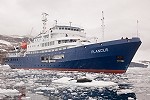 |
The ship: M/v "Plancius"
M/v "Plancius" accommodates 114 passengers in 53 passenger cabins with private toilet and shower in 4 quadruple private cabins, 39 twin private cabins (ca. 15 square meters) and 10 twin superior cabins (ca. 21 square meters).
M/v "Plancius" is manned by 17 nautical crew, 19 hotel staff (6 chefs, 1 hotel manager, 1 steward-barman and 11 stewards / cabin cleaners), 8 expedition staff (1 expedition leader and 7 guides-lecturers) and 1 medical doctor.
The ship is comfortable and nicely decorated, but is not a luxury vessel. Our voyages in the Arctic and Antarctic regions are and will still be primarily defined by an exploratory educational travel programme, spending as much time ashore as possible. This vessel will fully meet our demands to achieve this.
M/v "Plancius" accommodates 114 passengers in 53 passenger cabins with private toilet and shower in 4 quadruple private cabins, 39 twin private cabins (ca. 15 square meters) and 10 twin superior cabins (ca. 21 square meters).
M/v "Plancius" is manned by 17 nautical crew, 19 hotel staff (6 chefs, 1 hotel manager, 1 steward-barman and 11 stewards / cabin cleaners), 8 expedition staff (1 expedition leader and 7 guides-lecturers) and 1 medical doctor.
The ship is comfortable and nicely decorated, but is not a luxury vessel. Our voyages in the Arctic and Antarctic regions are and will still be primarily defined by an exploratory educational travel programme, spending as much time ashore as possible. This vessel will fully meet our demands to achieve this.
If interested in this journey, kindly


